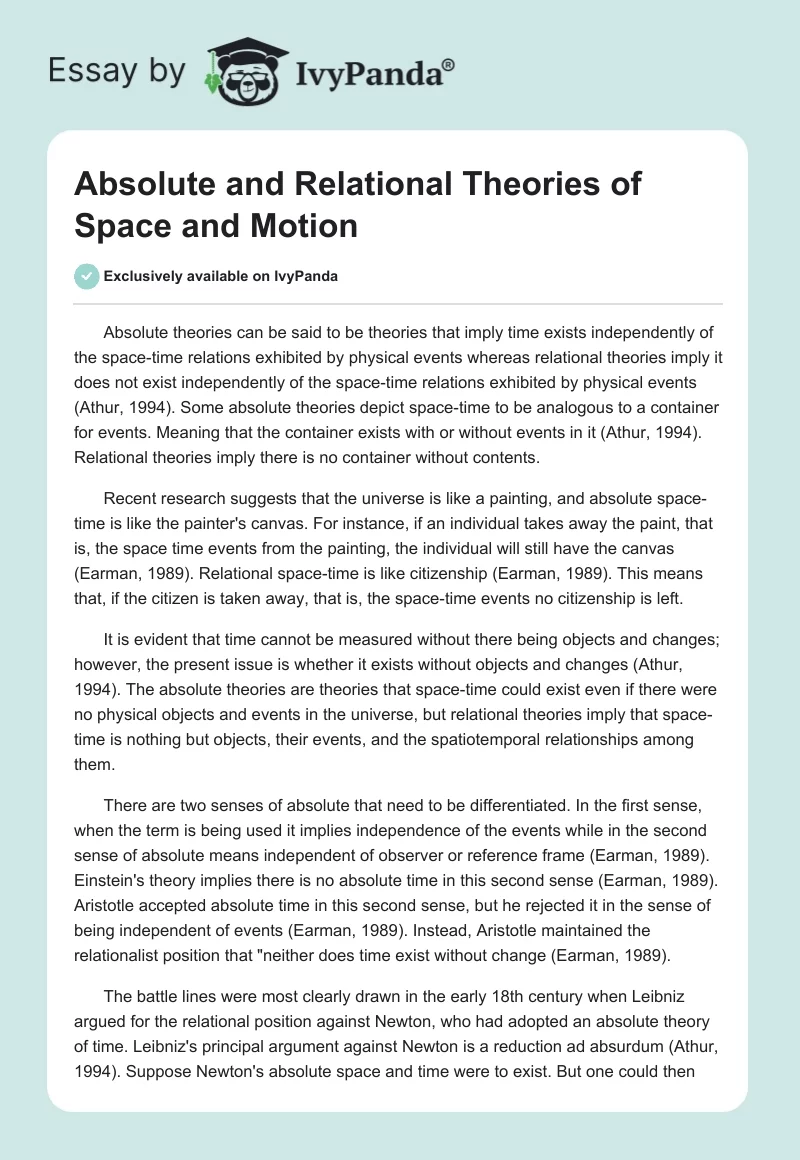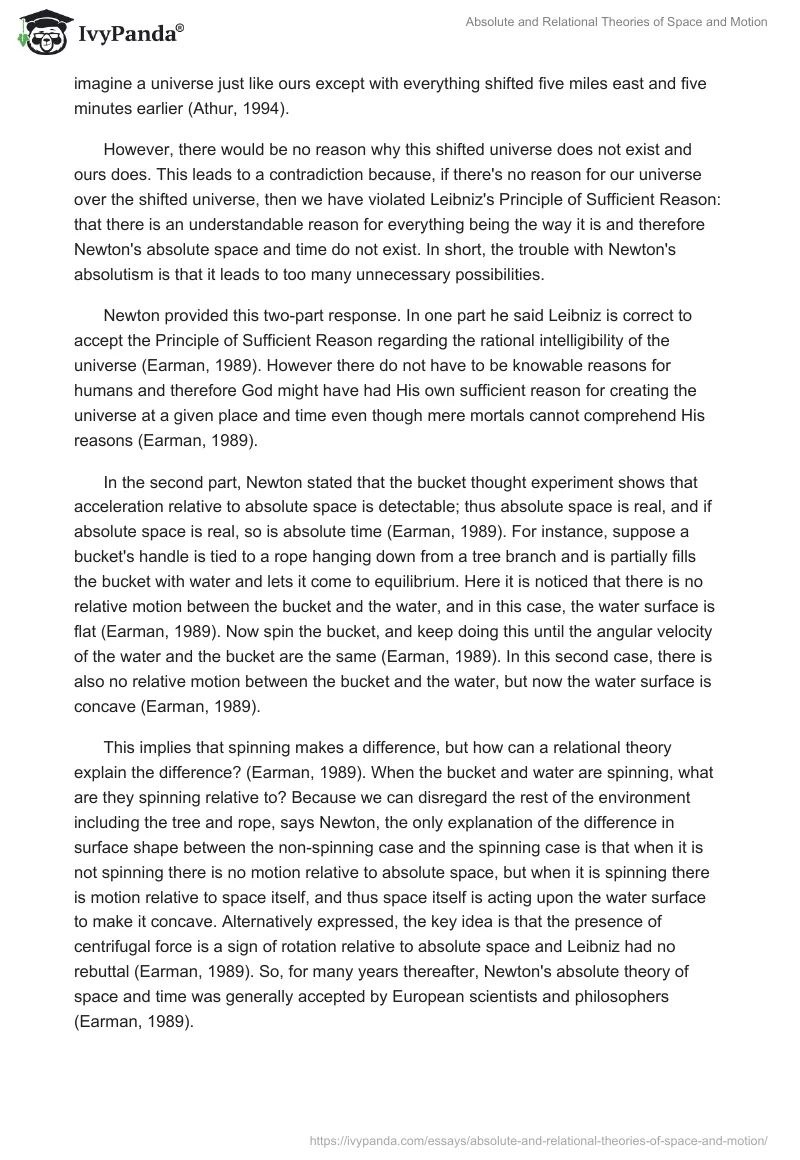Absolute theories can be said to be theories that imply time exists independently of the space-time relations exhibited by physical events whereas relational theories imply it does not exist independently of the space-time relations exhibited by physical events (Athur, 1994). Some absolute theories depict space-time to be analogous to a container for events. Meaning that the container exists with or without events in it (Athur, 1994). Relational theories imply there is no container without contents.
Recent research suggests that the universe is like a painting, and absolute space-time is like the painter’s canvas. For instance, if an individual takes away the paint, that is, the space time events from the painting, the individual will still have the canvas (Earman, 1989). Relational space-time is like citizenship (Earman, 1989). This means that, if the citizen is taken away, that is, the space-time events no citizenship is left.
It is evident that time cannot be measured without there being objects and changes; however, the present issue is whether it exists without objects and changes (Athur, 1994). The absolute theories are theories that space-time could exist even if there were no physical objects and events in the universe, but relational theories imply that space-time is nothing but objects, their events, and the spatiotemporal relationships among them.
There are two senses of absolute that need to be differentiated. In the first sense, when the term is being used it implies independence of the events while in the second sense of absolute means independent of observer or reference frame (Earman, 1989). Einstein’s theory implies there is no absolute time in this second sense (Earman, 1989). Aristotle accepted absolute time in this second sense, but he rejected it in the sense of being independent of events (Earman, 1989). Instead, Aristotle maintained the relationalist position that “neither does time exist without change (Earman, 1989).
The battle lines were most clearly drawn in the early 18th century when Leibniz argued for the relational position against Newton, who had adopted an absolute theory of time. Leibniz’s principal argument against Newton is a reduction ad absurdum (Athur, 1994). Suppose Newton’s absolute space and time were to exist. But one could then imagine a universe just like ours except with everything shifted five miles east and five minutes earlier (Athur, 1994).
However, there would be no reason why this shifted universe does not exist and ours does. This leads to a contradiction because, if there’s no reason for our universe over the shifted universe, then we have violated Leibniz’s Principle of Sufficient Reason: that there is an understandable reason for everything being the way it is and therefore Newton’s absolute space and time do not exist. In short, the trouble with Newton’s absolutism is that it leads to too many unnecessary possibilities.
Newton provided this two-part response. In one part he said Leibniz is correct to accept the Principle of Sufficient Reason regarding the rational intelligibility of the universe (Earman, 1989). However there do not have to be knowable reasons for humans and therefore God might have had His own sufficient reason for creating the universe at a given place and time even though mere mortals cannot comprehend His reasons (Earman, 1989).
In the second part, Newton stated that the bucket thought experiment shows that acceleration relative to absolute space is detectable; thus absolute space is real, and if absolute space is real, so is absolute time (Earman, 1989). For instance, suppose a bucket’s handle is tied to a rope hanging down from a tree branch and is partially fills the bucket with water and lets it come to equilibrium. Here it is noticed that there is no relative motion between the bucket and the water, and in this case, the water surface is flat (Earman, 1989). Now spin the bucket, and keep doing this until the angular velocity of the water and the bucket are the same (Earman, 1989). In this second case, there is also no relative motion between the bucket and the water, but now the water surface is concave (Earman, 1989).
This implies that spinning makes a difference, but how can a relational theory explain the difference? (Earman, 1989). When the bucket and water are spinning, what are they spinning relative to? Because we can disregard the rest of the environment including the tree and rope, says Newton, the only explanation of the difference in surface shape between the non-spinning case and the spinning case is that when it is not spinning there is no motion relative to absolute space, but when it is spinning there is motion relative to space itself, and thus space itself is acting upon the water surface to make it concave. Alternatively expressed, the key idea is that the presence of centrifugal force is a sign of rotation relative to absolute space and Leibniz had no rebuttal (Earman, 1989). So, for many years thereafter, Newton’s absolute theory of space and time was generally accepted by European scientists and philosophers (Earman, 1989).
One hundred years later, Kant entered the arena on the side of Newton (Athur, 1994). According to Kant in a space containing only a single glove, Leibniz could not account for its being a right glove versus a left glove because all the internal relationships would be the same in either case (Athur, 1994). However, it is a well-known fact that there is a real difference between a right and a left glove, so this difference can only be due to the glove’s relationship to space itself (Athur, 1994). However, if there is space itself then the absolute theory is better than the relational theory (Athur, 1994).
Newton’s absolute theory of the time was dominant in the 18th and 19th centuries, even though during those centuries Huygens, Berkeley, and Mach had entered the arena on the side of Leibniz. In the 20th century, Reichenbach and the early Einstein declared the special theory of relativity to be a victory for the relational theory. Special relativity, they said, ruled out a space-filling aether, the leading candidate for absolute space, so the absolute theory was incorrect (Earman, 1989). And the response to Newton’s bucket argument is to note Newton’s error in not considering the environment (Earman, 1989). According to general relativity, if you hold the bucket still but spin the background stars, the water will creep up the side of the bucket (Earman, 1989).
However, some philosophers argued that Reichenbach and the early Einstein may have been overstating the amount of metaphysics that can be extracted from physics. It can be argued that there is absolute in the sense of independent of the reference frame and absolute in the sense of independent of events (Earman, 1989). Which sense is ruled out when we reject a space-filling aether? (Athur, 1994) The critics of Reichenbach and the early Einstein admit that relativity theory does provide an effective response to Newton’s bucket experiment, which was a classical thought experiment favoring the absolute theory (Athur, 1994). And they admit that general relativity does show that the curvature of space-time is affected by the distribution of matter, so today it is no longer plausible for an absolutist to assert that the container is independent of the matter it contains (Athur, 1994). But, they argue, general relativity does not rule out a more sophisticated absolute theory (Athur, 1994). By the end of the 20th century, absolute theories had gained some ground thanks to the arguments of Adolf Grünbaum, John Earman, and Michael Friedman (Athur, 1994).
In 1969, Sydney Shoemaker presented an argument to convince us of the understandability of time existing without change, as Newton’s absolutism requires (Earman, 1989). For his case, if space is divided into three disjoint regions, called region 3, region 4, and region 5 it is certain that in region 3, change ceases every third year for one year (Earman, 1989). And that People in regions 4 and 5 can verify this and convince the people in region 3 after they come back to life at the end of their frozen year (Earman, 1989). Similarly, change ceases in region 4 every fourth year for a year; and change ceases in region 5 every fifth year (Earman, 1989). Every sixty years, that is, every 3 x 4 x 5 years, all three regions freeze simultaneously for a year (Earman, 1989). In the year sixty-one, everyone comes back to life, time has marched on for a year with no change (Earman, 1989). But philosophers of the time argued that even if time’s existing without change is understandable, the deeper question is whether time does exist without change (Earman, 1989).
Here is one argument for absolutism which states that there can be no “empty” time, the relational says. If events occur in a room before and after 11:01 AM, but not exactly at 11:01 AM, must the relational say there never was a time of 11:01 AM in the room? (Earman, 1989) To avoid saying “yes,” which would be absurd, a relationalist might say 11:01 exists in the room and everywhere else because somewhere outside the room something is happening then and somehow or other sense can be made of time in the room in terms of these external events (Earman, 1989). The absolutist then asks us to consider the possibility that the room is the whole universe (Earman, 1989). In that case, the relational response to losing 11:01 AM would probably be to say possible events occur then in the room even if actual events do not. But now look where we are, says the absolutist. If the relational theory is going to consider space-time points to be permanent possibilities of the location of events, then the relational theory collapses into substantivalism (Earman, 1989). This is because, to a substantivalist, a space-time point is also just a place where something could happen (Earman, 1989).
Hartry Field offers another argument for the absolute theory by pointing out that modern physics requires gravitational and electromagnetic fields that cover space-time (). They are states of space-time. These fields cannot be states of some Newtonian aether, but there must be something to have the field properties.
The proof of the infinitude of the given world-series and of the world-whole rests upon the fact that, on the contrary assumption, an empty time and an empty space must constitute the limit of the world (Athur, 1994). It is certain that attempts have been made to evade this conclusion by arguing that a limit of the world in time and space is quite possible without our having to make the impossible assumption of an absolute time prior to the beginning of the world, or an absolute space extending beyond the real world (Athur, 1994).
References
Athur, R. (1994): Space and Relativity in Newton and Leibniz; in: British Journal for the Philosophy of Science 45 (1994) 219-240.
Earman, J. (1989): Leibniz and the Absolute vs. Relational Dispute; in: Leibnizian Inquiries. A Group of Essays, ed. by N.Rescher; Lanham-New York-London 1989, 9-22. Web.


